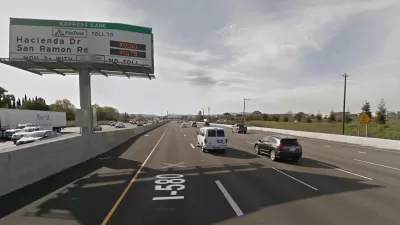Due to the high level of existing congestion, the Metropolitan Transportation Commission warns motorists that the new I-680 Contra Costa Express Lanes will offer relief just before and after the peak commute hour.
Michael Cabanatuan of the San Francisco Chronicle reports on the new high occupancy toll (HOT) lanes through the San Ramon Valley in Contra Costa County, the first express lanes to be constructed and operated by the Bay Area's metropolitan planning organization, the Metropolitan Transportation Commission (MTC).
“This is not going to eliminate congestion in the 680 corridor,” said John Goodwin of MTC. “Absolutely expect it to relieve congestion, especially ... just before and after peak travel times. But during periods of consistently very heavy traffic, during the peak, the express lanes may not move the needle a great deal."
If traffic is so heavy that the express lanes come to a slow crawl, only carpools will be allowed into the lane until the flow improves.
The lanes, converted from existing carpool lanes, stretch 11-12 miles in each direction, and will operate as express (or HOT) lanes from 5 a.m.-8 p.m., Monday through Friday, unlike Northern Virginia's I-66 lanes which will open in December as "the first rush-hour-only, peak-period toll system of its kind in the United States," as noted here on Tuesday.
Carpools, clean air vehicles, and motorcycles continue to get break
Unlike the I-66 HOT lanes, though, "clean air vehicles" will continue to use the converted high occupancy vehicle (HOV) lanes toll-free provided they have the white or green decals and a FasTrak Flex toll transponder set in the 3+ position. Carpools also will continue to operate toll-free provided they have the flex toll transponder set in either the 2 or 3+ position. Motorcycles need the flex transponder as well.
Congestion pricing will apply, with a minimum of $.50 for each of the two sections of the roadway. A maximum toll has not been set.
Network is growing
"With the addition of the 680 Contra Costa lanes, the Bay Area’s express lanes now cover 75 miles," adds Cabanatuan for The Chronicle. While these are the first lanes to be built and operated by the Bay Area Infrastructure Financing Authority, a joint powers authority between MTC and the Bay Area Toll Authority, other Bay Area express lanes fall under the authorities of the Santa Clara Valley Transportation Authority and the Alameda County Transportation Commission.
By 2035, regional transportation planners expect them to form a network that stretches 550 miles mostly in the East Bay and South Bay.
Coming next, in 2020, are express lanes on Interstate 880 between the southern tip of Oakland and Highway 237 in Milpitas and an extension of the Contra Costa lanes in the southbound direction to Marina Vista in Martinez [click on "Martinez to Walnut Creek" near the bottom of page].
Both of these projects are spearheaded by MTC. Click here for a map of the entire 550-mile Bay Area Express Lane network, with links to details for each corridor.
For more details on the I-680 Contra Costa Express Lanes, click on 511.org/driving/express-lanes/work.
Hat tip: AASHTO Daily Transportation Update.
FULL STORY: Express lanes to help ease congestion in 680 corridor

Alabama: Trump Terminates Settlements for Black Communities Harmed By Raw Sewage
Trump deemed the landmark civil rights agreement “illegal DEI and environmental justice policy.”

Planetizen Federal Action Tracker
A weekly monitor of how Trump’s orders and actions are impacting planners and planning in America.

Why Should We Subsidize Public Transportation?
Many public transit agencies face financial stress due to rising costs, declining fare revenue, and declining subsidies. Transit advocates must provide a strong business case for increasing public transit funding.

Understanding Road Diets
An explainer from Momentum highlights the advantages of reducing vehicle lanes in favor of more bike, transit, and pedestrian infrastructure.

New California Law Regulates Warehouse Pollution
A new law tightens building and emissions regulations for large distribution warehouses to mitigate air pollution and traffic in surrounding communities.

Phoenix Announces Opening Date for Light Rail Extension
The South Central extension will connect South Phoenix to downtown and other major hubs starting on June 7.
Urban Design for Planners 1: Software Tools
This six-course series explores essential urban design concepts using open source software and equips planners with the tools they need to participate fully in the urban design process.
Planning for Universal Design
Learn the tools for implementing Universal Design in planning regulations.
Caltrans
Smith Gee Studio
Institute for Housing and Urban Development Studies (IHS)
City of Grandview
Harvard GSD Executive Education
Toledo-Lucas County Plan Commissions
Salt Lake City
NYU Wagner Graduate School of Public Service




























